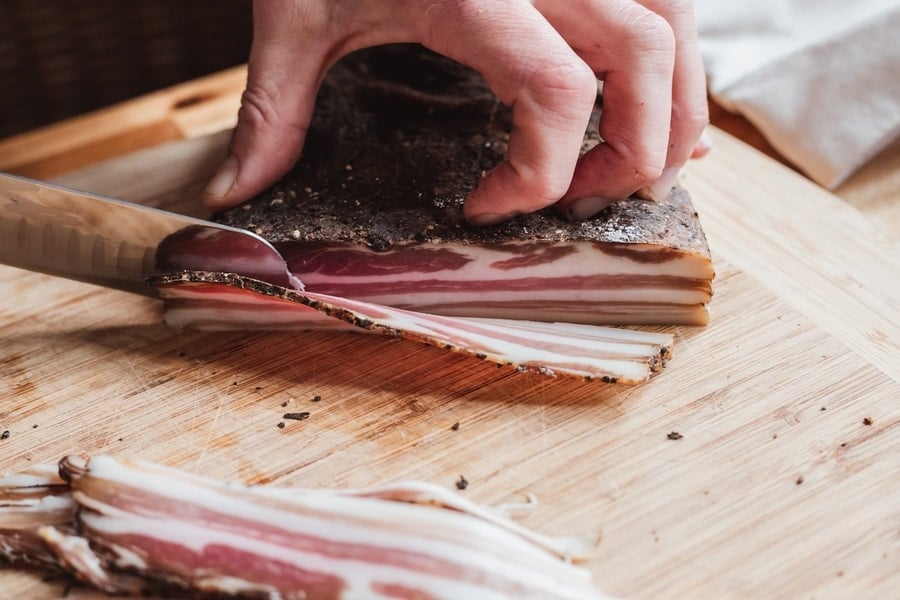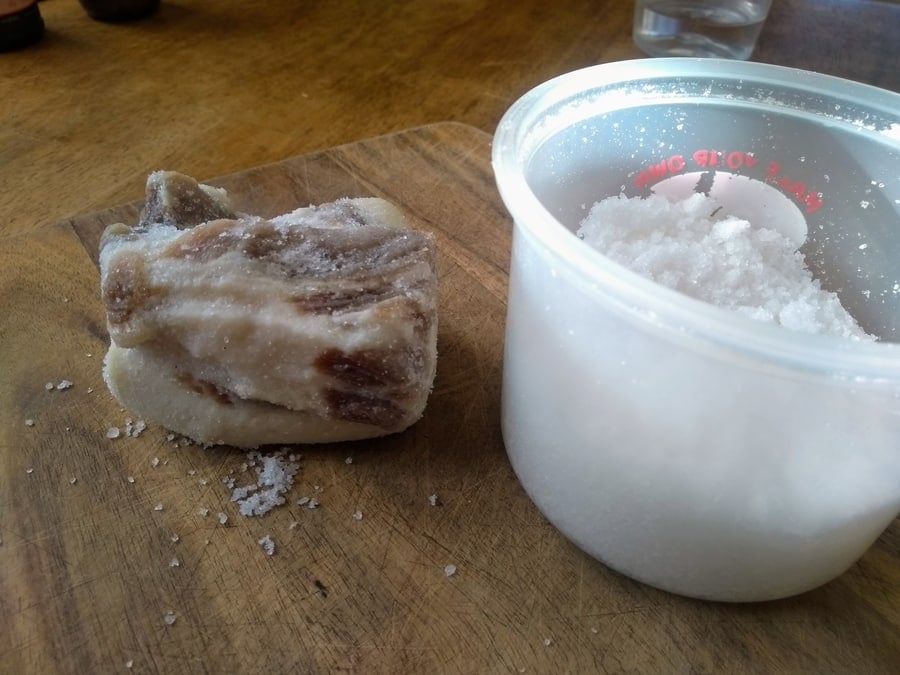In the world of cured meat, salt pork and pancetta often look similar at first glance. Yet, once you’ve worked with both, their differences become very clear.
I’ve made both over the years, for hearty stews or a refined Italian-style salumi board. They share some overlap in ingredients, but the results and uses are pretty distinct.
Key differences between salt pork and pancetta include:
- Appearance
- Origin
- Edibility
- Curing Process
- Amount of Meat and Fat
Once you notice these, you’ll never mistake one for the other again.
Salt pork is a humble preservation classic — pork belly heavily salted to keep it shelf-stable and intensely flavorful. I’ve used it as a simple addition of flavor to beans, stews, or slow-cooked greens. It’s all about the salty, fatty richness.

Pancetta, on the other hand, is a carefully balanced Italian dry-cured meat. It’s seasoned with spices, dried slowly, and developed for depth of flavor rather than just preservation.
Salt pork was built for survival — used by sailors and explorers to preserve calories for months. Pancetta was made for enjoyment, crafted by artisans focused on taste, aroma, and texture.
That difference in purpose is what sets them apart. One exists to preserve; the other exists to delight.

Overall Appearance
When you look at salt pork and pancetta side by side, the differences are apparent. Pancetta is leaner, pink, and elegant. Salt pork is dense, pale, and rugged.
- Salt Pork: Whitish and firm, often packed in coarse salt or brine and usually sold in slabs or thick slices.
- Pancetta: Pink to rose-red, often rolled (arrotolata) or flat (tesa), with visible streaks of meat and fat.
Salt pork looks closer to solid back fat or lard, while pancetta resembles bacon — but it’s cured, not smoked. You’d never want to eat salt pork raw, but pancetta can be sliced wafer thin and enjoyed as-is.
In Italian markets, pancetta is displayed beautifully — rolled and tied, sliced paper-thin, or cubed for cooking. Salt pork, by contrast, has a more utilitarian look, often found vacuum-sealed or in rustic butcher blocks.

Origin and History
Pancetta has deep Italian roots. It evolved from centuries of craft in regions like Emilia-Romagna and Calabria, where each town developed its own variations using local spices and curing traditions.
Salt pork, however, has an even longer global history. Before refrigeration, salt was the main way to preserve meat. Explorers and sailors carried barrels of salt pork on long voyages because it could last months without spoiling.
Pancetta’s goal was refinement. It was meant for taste — not survival. The Italian approach focused on balance: salt, time, air, and patience. It represents the art of dry curing perfected through generations.
Salt pork represents necessity. It’s what made cured meat practical and transportable before modern preservation. Different cultures used their own versions — from American settlers to Northern European sailors.
So while both share pork belly as their foundation, their histories diverged: pancetta as an Italian delicacy, salt pork as a survival staple.
Edibility and How to Use Each
Knowing whether you can eat pancetta or salt pork straight from the fridge is a key difference. One is ready to serve; the other needs heat.
Pancetta is cured and dried until it’s safe to eat without cooking. It’s handled much like prosciutto — thinly sliced and enjoyed raw, or used to add depth to pastas and risottos. I often use it diced in carbonara or wrapped around vegetables before roasting.
Salt pork, on the other hand, is far too salty to eat uncooked. It’s traditionally simmered, boiled, or rendered in stews and soups. Before cooking, I often rinse or soak it to reduce the salt content. It’s not meant to stand alone — it’s a background flavor enhancer.
If you want to try it yourself, here’s my process for how to make salt pork at home. It’s incredibly simple: pork belly, salt, and time. That’s it.
Curing Process and Flavor Development
Both pancetta and salt pork depend on salt for preservation, but the approach and outcome are completely different.
Salt pork is packed heavily with salt and sometimes sugar, and stored in a cool environment for weeks or months. The result is a dense, salty block of fat and meat — long-lasting, but with a narrow flavor range.
Pancetta uses a gentler balance of salt, sugar, herbs, and spices, then dries slowly in controlled temperature and humidity. Over several weeks, enzymes and airflow create complex aromas — this is where curing environment matters most.
Unlike salt pork, pancetta requires careful drying. This balance of temperature, humidity, and time determines how the meat safely transforms. For home curing, I follow equilibrium-curing principles—precise salt ratios rather than guesswork. If you’re curious, here’s my full equilibrium curing guide.
The difference shows in taste. Pancetta develops deep savory notes and a smooth mouthfeel. Salt pork stays sharp, briny, and intense — built for seasoning, not snacking.
When I dry-cure pancetta, I focus on airflow, timing, and spice ratios. Each small change affects texture and aroma. Salt pork, by comparison, is forgiving — salt it and wait (which is funny because it’s classic prosciutto but a lot less refined in many ways, same ingredients slightly, but the Parma Ham Prosciutto pig, for instance, is something of strict quality in Italy).
Fat Content And Amount Of Meat
Both come from pork belly, but the ratio of fat to lean is not the same.
- Salt pork: Higher fat, denser, and often made from older, fattier bellies. It shrinks less because fat holds less water.
- Pancetta: More visible lean streaks, tighter grain, and a cleaner bite when sliced thin.
If you want a delicate pork flavor with some chew, pancetta wins. If you want rich salinity and rendered fat for a pot of beans, salt pork is ideal.
When To Use Each
Use pancetta when you want aroma, nuance, and thin (or thick for cooking) slices that stand alone. It’s perfect diced for soffritto or shaved onto warm dishes.
Use salt pork when you want structure and seasoning in the cooking liquid. Rinse or soak first if needed, then simmer to release flavor.
Think of pancetta as a finishing ingredient or centerpiece. Think of salt pork as a classic base note for hearty cooking.
For a broader cured pork context, this overview is useful: cured pork cuts explained. A concise primer on pancetta is here: what pancetta is and how it’s used.
Alternatives
- For pancetta: Prosciutto (uncooked, thinly sliced), or dry-cured belly like guanciale for deeper intensity or coppa. For thin-sliced antipasti specifically.
- For salt pork: Bacon with smoke trimmed back (parboil first), or fatty pork belly cured simply with salt.
FAQ – Salt Pork vs Pancetta
Is pancetta the same as bacon?
No. Bacon is usually smoked and must be cooked. Pancetta is dry-cured and dried; it can be eaten thinly sliced without cooking or used as a cooking ingredient.
Can I substitute salt pork for pancetta?
Sometimes, but expect different results. Salt pork is far saltier and fattier. Rinse or soak, then use smaller amounts. It will season stews; it will not replicate pancetta’s delicate sliced texture.
Do I need to cook pancetta?
No, not required. Properly cured and dried pancetta can be eaten as-is. Many dishes also benefit from lightly rendering it for aroma and fat.
How do I make salt pork less salty?
Rinse under cold water, then soak 15–30 minutes and pat dry. Taste the cooking liquid before adding any extra salt.
Questions or experiences with pancetta and salt pork? Drop a comment below — I read every one.

Tom Mueller
For decades, immersed in studying, working, learning, and teaching the craft of meat curing, sharing the passion and showcasing the world of charcuterie and smoked meat. Read More
